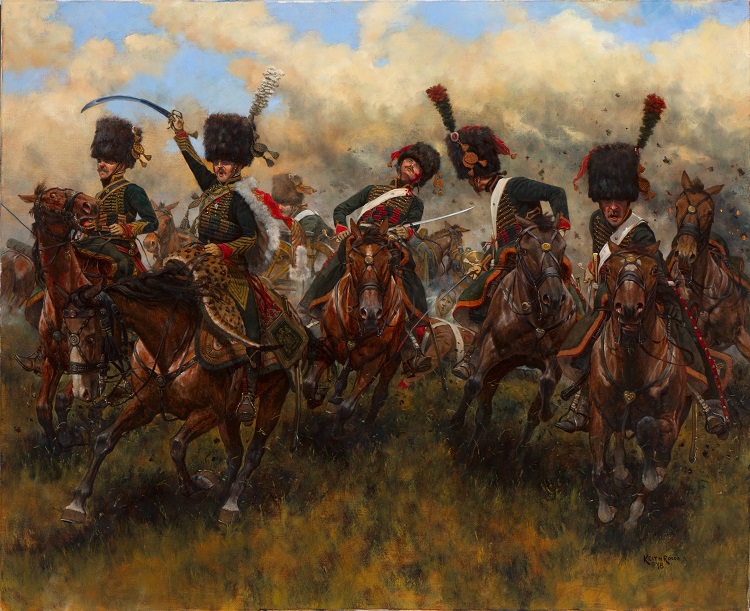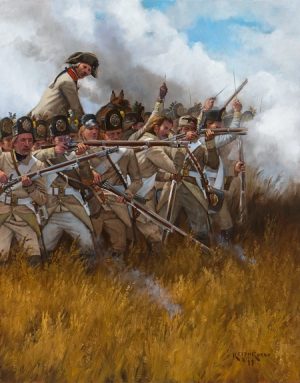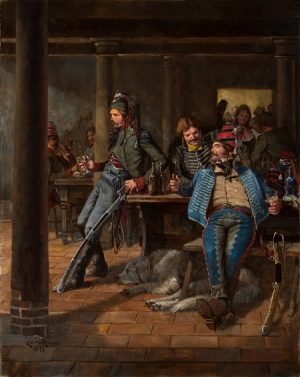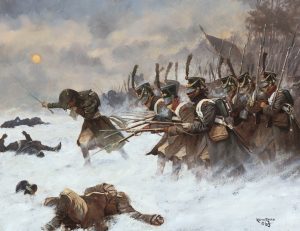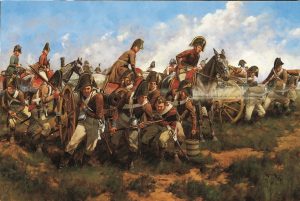The Invincibles
Description
50 signed and numbered prints
‘Colonel’ Guyot and the Chasseurs a Cheval de la Garde at Wagram
July 5,1809 saw Napoleon’s army erupt from its bridgeheads along the Danube River and advance onto the Marchfeld, the Austrian’s army’s peacetime maneuver ground. Just over 1,000 troopers of the Imperial Guard chasseurs à cheval participated. The unit operated in two divisions, referred to as “regiments,” each commanded by newly promoted majors: the magnificent Pierre Daumesnil, who had already endured nineteen battle wounds, and gallant Hercule Corbineau. Colonel Claude-Étienne Guyot, also newly promoted, led the entire unit.
The Austrians steadily withdrew before the onslaught. The Imperial Guard light cavalry joined the slow advance, “never knowing where we would find the Austrian army.” That night, the troopers settled into an uncomfortable bivouac lacking food, drink, and fodder for their horses. The following morning, July 6, before the troopers were fully awake, the roar of cannon drowned the sounds of the regimental bands playing reveille. The Austrians had launched a massive, surprise attack along the Danube River.
Soon battle smoke extended from the river all the way to the French right flank.
The Austrian assault forced Napoleon to adjust his battle plan. The Emperor judged that the Austrian line was over-extended. Hence, he would deliver a battle-winning counterattack against the Austrian center. Napoleon assembled a grand battery composed of some 110 artillery tubes. While the rival artilleries were exchanging punishing fire, Napoleon rode up to an Imperial Guard horse battery and spoke, “There is where we will make our breach.” After the massed batteries had done their work, the French cavalry would support Marshal Macdonald’s attack which aimed toward the bell tower at Süssenbrunn.
Marshal Bessières personally led the French heavy cavalry in a series of charges against FZM Kolowrat’s corps and the adjacent grenadiers commanded by FML d’Aspre. It proved a perilous position. Bessierès’s horse was shot out from under him. That shot broke the chain of command. While the dazed marshal struggled to recover, the French cavalry mingled in confusion. A second-lieutenant in the Guard chasseurs à cheval recalled how balls, shells, and canister crippled the regiment: “my file chief was killed, I replaced him…the man who replaced me was killed. The troopers on my right and left were also knocked down…a canister round struck my captain in the middle of his back while another killed his horse…At the same time, cannon fire killed both mine and two adjacent horses.” The summer-ripened wheat caught fire, burning to death the wounded who could not escape. A cannon shot struck Major Daumesnil’s left leg, ultimately requiring its amputation. A canister round fractured Major Corbineau’s right shoulder. About twenty-five Guard chasseurs à cheval were killed during this phase of the battle. Finally, Austrian counterattacks forced the ‘Cherished Children’ to withdraw.
Napoleon perceived that the attack was stalled. He committed fresh soldiers to the attack and ordered additional batteries to the gunline. He rode along the lines, calling out to each colonel of cavalry: “Let us go! Vigorously, and when it is time, charge them down.” Finally the cumulative pressure overwhelmed the Austrians. Major General Walther placed both Guard light cavalry regiments under Guyot’s command and ordered him to pursue the retiring Austrians. On the high ground of the Bisamberg, an Austrian rearguard of cavalry and infantry deployed to cover the route to Brünn. Guyot’s troopers charged and defeated the Schwarzenberg Uhlans only to find themselves caught again in “a volcano of fire.” The Guard chasseurs à cheval made several more gallant charges. Guyot wrote: “The 1st Regiment was thrown back once because the infantry was formed in squares and killed ten of our men and as many horses. But I gave a lecture to the 2nd Regiment that convinced them we were the stronger. Of the enemy’s three guns, we captured one.” A French eyewitness recalled that the Austrian army retired “in very good order without a hint of panic.”
Not since the terrible winter Battle of Eylau in 1807, had the Guard chasseurs à cheval endured such losses. The regiment lost both majors and a squadron chef wounded; two captains and two lieutenants killed, seven more lieutenants wounded; 50 troopers killed, 150 wounded. Napoleon praised his ‘cherished children’ for their conduct at the Battle of Wagram. He asserted that they had “broken three squares” and “captured four artillery pieces.” He lamented the deaths of so many troopers, but emphasized that “their glorious epitaph…killed during the affair at Wagram” deserved high respect. Subsequently, the regiment received the honor of adding ‘Wagram’ to its battle standard.
This latest painting by Keith Rocco depicts the charge of the Chasseurs a Cheval de la Garde led personally by Colonel Guyot. The scene depicts the moment when the troopers have broken through the Austrian battery, their impetus carrying them onward towards their next target.
Additional information
| Medium | |
|---|---|
| Size | 20" x 24", 15" x 18" |
| Type |

